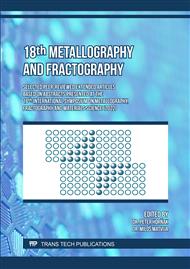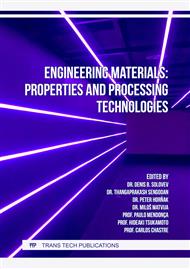[1]
H. Y. Song, H. T. Liu, H. H. Lu, H. Z. Li, W. Q. Liu, X. M. Zhang, G. D. Wang, Effect of hot rolling reduction on microstructure, texture and ductility of strip-cast grain-oriented silicon steel with different solidification structures, Materials Science and Engineering: A. 605 (2014) 260-269.
DOI: 10.1016/j.msea.2014.03.052
Google Scholar
[2]
J. Y., Park, K. H., Oh, H. Y, Ra, Microstructure and crystallographic texture of strip-cast 4.3 wt.% Si steel sheet, Scripta materialia, 40 (8) (1999) 881-885.
DOI: 10.1016/s1359-6462(99)00044-5
Google Scholar
[3]
H.-Y. Song, et al., Microstructure and texture evolution of strip casting grain-oriented silicon steel, IEEE Transactions on Magnetics, 51 (11) (2015) 1-4.
DOI: 10.1109/intmag.2015.7156865
Google Scholar
[4]
Z. Xia, Y. Kang, Q. Wang, Developments in the production of grain-oriented electrical steel, Journal of Magnetism and Magnetic Materials, 320 (23) (2008) 3229-3233.
DOI: 10.1016/j.jmmm.2008.07.003
Google Scholar
[5]
Y. Hayakawa. Mechanism of secondary recrystallization of Goss grains in grain-oriented electrical steel, Science and Technology of Advanced Materials, 18 (1) (2017) 480-497
DOI: 10.1080/14686996.2017.1341277
Google Scholar
[6]
K. Günther, et al., Recent Technology Developments in the Production of Grain-Oriented Electrical Steel. Steel research international, 76 (6) (2005) 413-421.
DOI: 10.1002/srin.200506030
Google Scholar
[7]
T. Kubota, M. Fujikura, Y. Ushigami, Recent progress and future trend on grain-oriented silicon steel, Journal of Magnetism and Magnetic Materials, 215 (2000) 69-73.
DOI: 10.1016/s0304-8853(00)00069-x
Google Scholar
[8]
H. T. Liu, S. J. Yao, Y. Sun, F. Gao, H. Y. Song, G. H. Liu, G. D. Wang, Evolution of microstructure, texture and inhibitor along the processing route for grain-oriented electrical steels using strip casting, Materials Characterization, 106 (2015) 273-282.
DOI: 10.1016/j.matchar.2015.06.010
Google Scholar
[9]
V. Vodárek, C. P. Reip, A. Volodarskaja, Microstructure Evolution in Belt-Casted Strip of Grain Oriented Electrical Steel, Trans Tech Publications Ltd. Key Engineering Materials, 810 (2019) 82-88.
DOI: 10.4028/www.scientific.net/kem.810.82
Google Scholar
[10]
Y. Ohmori, K. Nakai, H. Ohtsubo, Y. Isshiki. Mechanism of Widmanstätten austenite formation in a δ/γ duplex phase stainless steel, ISIJ international, 35 (8) (1995) 969-975.
DOI: 10.2355/isijinternational.35.969
Google Scholar
[11]
H. Y. Song, H. T. Liu, G. D. Wang, J. J. Jonas, Formation of Widmanstätten austenite in strip cast grain-oriented silicon steel, Metallurgical and Materials Transactions A, 48 (4) (2017) 1959-1968.
DOI: 10.1007/s11661-017-3975-3
Google Scholar
[12]
W. B. Pearson, A handbook of lattice spacings and structures of metals and alloys, London, Pergamon Press, 1958.
Google Scholar



